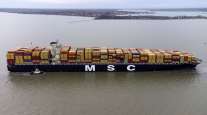Ships Carrying 50,000 Containers Are on Horizon, Report Says

Container ships just keep getting bigger and bigger. Today’s top dog, the OOCL Hong Kong, can carry a mind-boggling 21,413 boxes – far more than the largest ship ever to call on the Port of Hampton Roads.
So it’s only natural to ask: Are we nearing the limit of what’s possible?
To which McKinsey & Co., a New York-based consulting firm, has an emphatic answer:
Not even close.
In a recent report about the next 50 years of the container shipping industry, the firm forecasts that by 2067, ships may be traversing the planet that are able to carry 50,000 containers – well over double the max.
The report also estimates that global volume will grow over the next 50 years from last year’s 182 million TEUs – 20-foot-equivalent container units – to between 464 million and 858 million in 2066.
The 50,000-container ship projection comes with some caveats, of course, including among other things the “narrowness and shallowness of some of the world’s waterways.”
But it concludes: “On balance, we do not view 20,000 TEUs as the natural end point for container ships – 50,000-TEU ones are not unthinkable in the next half-century.”
“It’s hard to fathom,” said Bill Cofer, president of the Virginia Pilot Association, whose members guide ships in and out of the harbor.
Cofer said that while he hasn’t read the study, he’s somewhat skeptical.

Chris Ratcliffe/Bloomberg
“If you take an objective view of what’s happening globally – just look at the major European and Asian ports,” he said. “There is a point at which everyone in the world would have to do these massive dredging projects.”
In fact, ships all along the East Coast have been doing just that in recent years, preparing to handle the bigger vessels that can now transit the Panama Canal, ships able to carry up to 14,000 TEUs or so.
Projects are under way in Charleston, S.C., and Savannah, Ga., and the Port of Virginia is moving to get the OK to deepen and widen its channels to at least 55 feet and 1,200 feet, respectively, from 50 feet and 1,000 feet.
The McKinsey study states that the first ship to carry containers – the Ideal X in 1956 – moved just 58 of them.
Today, the OOCL Hong Kong – the biggest container ship in the world as of earlier this year – can carry 21,413 TEUs, a 370-fold increase, according to the report.
The biggest ships to hit the U.S. East Coast so far, including Virginia, can carry about 14,400 units. There are ships now on order that will carry about 22,000 TEUs.
That’s probably close to maxing out what ports around the world can handle, said Jim Newsome, president and CEO of the South Carolina Ports Authority, in a recent story about the McKinsey study in The Post and Courier of Charleston, S.C.
Newsome said that an ocean carrier had asked Charleston to simulate handling a 19,000-TEU ship, which he estimated would be about the biggest ship the port could handle due to harbor depth and the height of the Ravenel Bridge.
Cofer said that ocean carriers have talked with the Port of Virginia about the feasibility of bringing 16,000- to 18,000-TEU vessels to Hampton Roads.
“It is similar to the way five or six years ago they were asking us about 14,000,” he added. “The same group of people are trying to evaluate the global fleet.”
Cofer said he believed it “absolutely is possible” that the port could accommodate a 22,000-TEU ship. As for ships bigger than that? Naval architects could be thinking about super wide and long ships at current drafts, he added.
If they’re thinking about ships needing still deeper drafts, however, that could eventually require changes on the caps over the region’s bridge-tunnels, which are all at least 63 feet deep.
“It’s hard for me to think there’d be places around the world that could get that deep to make it economically viable for the shipping lines to have places to go,” he said.
Asked how realistic it is to even consider the port’s handling of a 50,000-TEU vessel, a Virginia Port Authority spokesman said many questions would need to be addressed.
“We’re always planning, we’re always looking for the next phase, the next evolution,” said Joe Harris. “Our focus, our goal, is to evolve with the industry.”
As far-fetched as the 50,000-TEU prediction may seem to some, McKinsey points out that it has a pretty good track record for reading the tea leaves, as it were.
In 1966-67, the British Transport Docks Board asked the company to weigh the impact of a new development from the United States – the use of cargo containers, which were considered “novelties” at the time.
“Containerization is emerging as the most important and far-reaching single factor in the movement of exports and imports through UK ports,” McKinsey’s 1966 cover letter stated. “... Our recommendations to your board at this stage are mainly that containerization be recognized as an urgent ‘fact of life.’ "
Distributed by Tribune Content Agency, LLC




